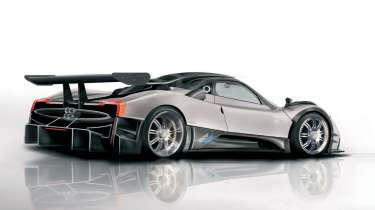Pagani Zonda: Pagani's 750bhp Ferrari FXX rival
Zonda bows out in style with a limited-edition, 1.1million-euro trackday special
Horacio Pagani chose the Geneva motor show to announce that he’s planning to produce one final, ultimate Zonda variant, to be called the Zonda R. And ultimate it certainly will be, with a price tag of 1.1million euros plus taxes (around £868,000) – over twice that of a Zonda F.
Despite the asking price, Horacio already has three firm orders for the car, but he is looking for two more deposits before confirming that the Zonda R will go into production (if more orders than this roll in then he intends to limit production to just ten examples, meaning exclusivity is guaranteed). We visited the Pagani factory a few days before the Geneva show to see for ourselves the work that has gone into this amazing car.
Horacio's aim for the R is simple: to build the ultimate version of the Zonda but without having to worry about the usual homologation hurdles.
herefore it won't be road-legal but will be a trackday-only car along the lines of Ferrari's FXX. Horacio is keen to differentiate the Zonda R from cars like the FXX, though, as he wants it to reflect the ultimate not only in performance but also in terms of quality and design, just as has been the case with all previous Paganis.
Don't think this is simply a Zonda F wearing a fancy bodykit, though. There are significant differences between the two cars, not least of which is a different engine. The Zonda R will have a development of the 600bhp, 6-litre V12 race unit originally designed for the Mercedes-Benz CLK-GTR.
In the CLK-GTR, the engine's power was limited by the mandatory air restrictors for GT racing. In the Zonda R, however, there will be no need for restrictors, so power will rise to 750bhp at a heady 8200rpm, with torque said to be 524lb ft.
The engine is dry-sumped – essential in car that can produce the levels of cornering g that the R is expected to, and enabling the engine to sit lower in the car, thus lowering the centre of gravity. Unlike in previous Zondas, this engine is bolted directly to the passenger cell and so becomes a structural member within the chassis.
A special exhaust system (using the familiar white ceramic-coated manifolds first seen on the Zonda F Clubsport) has been developed for use in the R, with the simple aim of making it the best sounding Zonda ever.
The R will also give Pagani the chance to try out some of the components that will go into next year’s Zonda replacement, currently codenamed 'C9' and expected to be revealed at next year’s Geneva show. Most significant amongst these will be a newly developed, bespoke six-speed gearbox that will offer a sequential change with a manual clutch. This gearbox could give Pagani the potential to introduce a paddle-shift gearchange option on the C9 once an electronically-activated clutch has been developed.
The new gearbox will be mounted transversely in the chassis, allowing the mass centre of the engine-plus-gearbox combination to move forwards in the chassis, improving balance as well as offering Pagani major aerodynamic advantages by freeing up the space around the rear of the car that was previously occupied by the conventional longitudinal gearbox. This revised layout allows the Zonda R to create significantly more downforce than before.
The wheelbase has increased by 60mm as a result of this new layout, while both the front and rear track are 50mm wider than before, contributing to fantastic stability and cornering forces which, according to Horacio, are ‘beyond your imagination’.
Inside the R it's typical Pagani, with a real feeling of luxury promoted by the choice of materials. Changes over the Zonda F include bespoke race- seats, a roll- cage, and the loss of the glass roof and rear window as a result of the addition of a huge air snorkel running over the top of the cockpit to feed cold air to the all-carbon intake manifold. The noise of the twelve hungry intake trumpets should feed directly back into the cockpit, adding to the aural experience.
In a unique move for a non-competition car, Pagani plans to fit weight sensors to each corner of the car, with four digital readouts on the dash allowing owners to see the loadings on each wheel as they drive. Horacio envisages that owners will have hours of fun changing the aerodynamic set-up on the car (via the adjustable wings) and then seeing what effect this has via the readouts.
The R's wheels will be forged magnesium, fitted with specially developed slick tyres and each secured by a single, central wheel nut. Changing them will be made even easier by an onboard pneumatic jacking system.
Also beneath the R's skin are new front and rear subframes, and a revised suspension layout that uses wider, lighter wishbones made from Avional alloy. Together with the 50kg lighter engine, this has helped reduce the kerb weight of the car to 1100kg – 130kg lighter than a Zonda F – meaning its power-to-weight ratio will be 693bhp/ton, eclipsing the 642bhp/ton of the Ferrari FXX.
One thing you can be sure of is that the Zonda R is going to be extraordinary to drive, and a fitting swansong to the car that has put Horacio Pagani’s fledgling company on a level with the world’s more established supercar manufacturers.



